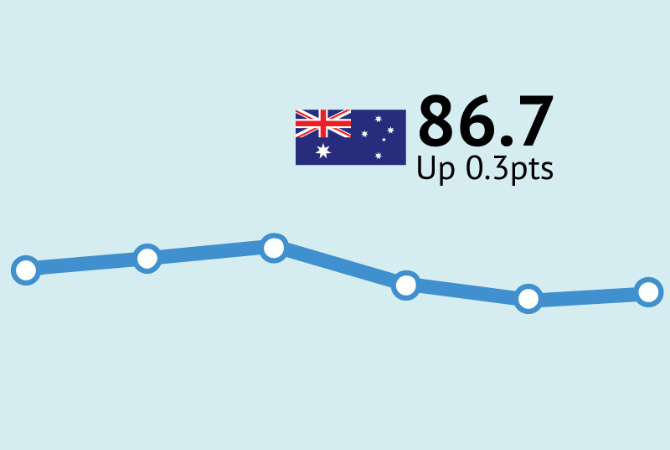ANZ-Roy Morgan Consumer Confidence virtually unchanged at 86.7, but ‘net buying sentiment’ improves to strongest since April 2022 as ‘End of Financial Year’ sales begin

ANZ-Roy Morgan Consumer Confidence was virtually unchanged at 86.7 in the week Australian GDP growth was estimated at only 1.3% over the last 12 months. Consumer Confidence is 9.7 points above the same week a year ago, June 3-9, 2024 (77.0) and in line with the 2025 weekly average of 86.5.
An analysis by State shows mixed results with Consumer Confidence increasing in New South Wales and Western Australia, but down slightly in Victoria, Queensland and South Australia – a reversal of last week’s results.
A look across the index shows positive movement for the buying sentiment indicator which was offset by increasing worries about the Australian economy’s performance over the next 12 months.
A fifth of Australians, 20% (up 2ppts), say their families are ‘better off’ financially than this time last year compared to 42% (unchanged) that say their families are ‘worse off’.
Net views on personal finances over the next year were virtually unchanged this week with 25% (down 1ppt) of respondents, expecting their family will be ‘better off’ financially this time next year (incredibly, this is the lowest figure for this indicator for over five years since late March 2020 at the beginning of the pandemic), while 30% (down 1ppt) expect to be ‘worse off’.
Views on the economy over the next year deteriorated this week with under one-in-eight Australians, 12% (down 2ppts), expecting ‘good times’ for the Australian economy over the next twelve months compared to nearly a third, 30% (up 2ppts), that expect ‘bad times’.
Net sentiment regarding the Australian economy in the longer-term was virtually unchanged this week with 13% (down 1ppt) of Australians expecting ‘good times’ for the economy over the next five years compared to a quarter, 25% (down 1ppt), expecting ‘bad times’.
Net buying intentions improved this week to their strongest since April 2022 as the ‘End of Financial Year’ sales began with 25% (up 2ppts) of Australians saying now is a ‘good time to buy’ major household items compared to 34% (down 2ppts) that say now is a ‘bad time to buy major household items’.
ANZ Economist, Sophia Angala, commented:

“ANZ-Roy Morgan Australian Consumer Confidence rose just 0.3pts last week to 86.7pts. The ‘time to buy a major household item’ subindex saw the largest rise, lifting to its highest level since April 2022. This was likely driven by the beginning of end-of-financial-year sales events. Household financial confidence also rose last week, driven by improvement in the 12-month outlook.
Soft headline GDP data last week may have driven weaker economic confidence. Although the data showed robust yearly growth in household disposable incomes and a per capita rise in real incomes, which should support upward momentum in ANZ-Roy Morgan Australian Consumer Confidence in the coming months.”

Check out the latest results for our weekly surveys on Business Confidence, Consumer Confidence, and Voting Intention as follows:
Roy Morgan Business Confidence Statistics
ANZ – Roy Morgan Consumer Confidence Statistics
Federal Voting – Government Confidence Rating
Related Research Reports
The latest Roy Morgan Consumer Confidence Monthly Report is available on the Roy Morgan Online Store. It provides demographic breakdowns for Age, Sex, State, Region (Capital Cities/ Country), Generations, Lifecycle, Socio-Economic Scale, Work Status, Occupation, Home Ownership, Voting Intention, Roy Morgan Value Segments and more
Consumer Confidence – Monthly Detailed Report in Australia.
Business Confidence – Monthly Detailed Report in Australia.
Consumer Banking Satisfaction - Monthly Report in Australia.
For comments or more information please contact:
Roy Morgan - Enquiries
Office: +61 (03) 9224 5309
askroymorgan@roymorgan.com
Margin of Error
The margin of error to be allowed for in any estimate depends mainly on the number of interviews on which it is based. Margin of error gives indications of the likely range within which estimates would be 95% likely to fall, expressed as the number of percentage points above or below the actual estimate. Allowance for design effects (such as stratification and weighting) should be made as appropriate.
| Sample Size | Percentage Estimate |
| 40% – 60% | 25% or 75% | 10% or 90% | 5% or 95% | |
| 1,000 | ±3.0 | ±2.7 | ±1.9 | ±1.3 |
| 5,000 | ±1.4 | ±1.2 | ±0.8 | ±0.6 |
| 7,500 | ±1.1 | ±1.0 | ±0.7 | ±0.5 |
| 10,000 | ±1.0 | ±0.9 | ±0.6 | ±0.4 |
| 20,000 | ±0.7 | ±0.6 | ±0.4 | ±0.3 |
| 50,000 | ±0.4 | ±0.4 | ±0.3 | ±0.2 |





